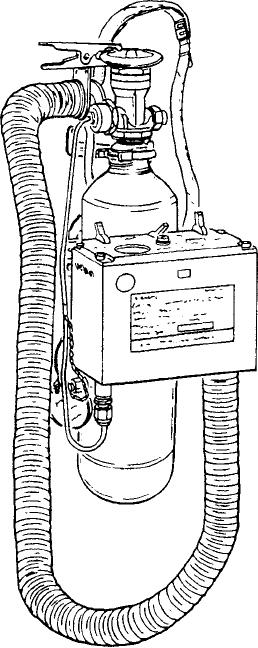
aircraft's structure. The cylinder bracket may be placed
SYSTEM OPERATION
horizontally or stood on end while in use. The straps
The pressure manifold, which is equipped with
can be used as a handle to carry it from place to place.
internal check valves, receives oxygen flow from the
Because of its weight, the walkaround unit should not
cylinders, directs the flow into a common line, and
be carried by its breathing tube, regulator, or copper
routes it to the pressure reducer. The manifold assembly
tubing.
also connects to a filler line, allowing the three
SYSTEM MAINTENANCE
cylinders to be recharged simultaneously from an
external supply. The pressure reducer decreases the
The maintenance procedures discussed in this
pressure to 65 psi. Incorporated on the low-pressure
section are general in nature. Consult the applicable
side of the pressure reducer is a relief valve, which
MIM prior to performing any maintenance on each
connects through tubing to an overboard discharge
specific type of aircraft. Routine maintenance includes
indicator. In the event of excessive pressure developing
servicing of cylinders, checking the system and
within the low-pressure section of the pressure reducer,
regulators for leaks, operationally checking the system,
the excess pressure will flow through the relief valve
and troubleshooting malfunctions.
and out the overboard discharge line. This flow will
rupture the green disc in the discharge indicator, giving
a visual indication of a malfunctioning pressure
reducer.
A line from the high-pressure side of the pressure
reducer connects to a gauge in the cockpit. This gauge
gives the pilot an indication of pressure in the three
storage cylinders.
Portable Oxygen Systems
Portable oxygen systems include walkaround
cylinders, survival kits, and bailout units. These
systems are used primarily to maintain crew functions
in the event of failure of the fixed oxygen systems. The
survival kit oxygen system also performs the same
function during descent after bailout. All of these are
small, lightweight, high-pressure, self-contained
gaseous systems, which are readily removed from the
aircraft.
Walkaround cylinders are standard equipment on
many transport, patrol, and early warning aircraft, and
are used separately or in addition to a permanently
installed oxygen system. Each system consists of a
reducer and regulator assembly mounted directly on a
small oxygen cylinder.
Figure 7-6 illustrates a high-pressure walkaround
oxygen system. It is a 295- or 514-cubic-inch capacity,
1,800-psi cylinder equipped with a regulator, which is
connected to the cylinder with a short coiled length of
copper tubing. A short flexible breathing tube, clamped
to the outlet of the regulator at one end and fitted with a
connector at the other end, provides the assembly for
the attachment of the demand mask tube. Straps
fastened to the cylinder bracket provide the means for
securing the unit to the user's seat or part of the
Figure 7-6.--Portable oxygen system.
7-8

